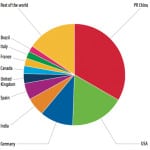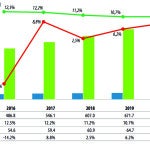Last year, the U.S. passed Germany to become a world leader in wind power installations, while China’s total capacity doubled for the fourth year in a row, the Global Wind Energy Council (GWEC) said last week. Total worldwide installations in 2008 were more than 27,000 MW, dominated by the three main markets in Europe, North America, and Asia.
Global wind energy capacity (PDF) grew by 28.8% last year, even higher than the average over the past decade, to reach total global installations of more than 120.8 GW at the end of 2008. Over 27 GW of new wind power generation capacity came online in 2008, 36% more than in 2007.
The global market for wind turbine installations in 2008 was worth about $47.5 billion. More than 400,000 people were employed in the industry. GWEC said that these figures show that wind energy is now an important player in the world’s energy markets.
The leading markets in terms of new installed capacity in 2008 were the U.S. and China. New U.S. wind energy installations totaled 8,358 MW for a total installed capacity of 25,170 MW, making it the world leader in installed capacity. According to the American Wind Energy Association (AWEA), installed capacity in the U.S. in 2008 shattered all previous records—though AWEA warned of an uncertain outlook for 2009 due to the continuing financial crisis.
“The massive growth in 2008 swelled the nation’s total wind power generating capacity by 50% and channeled an investment of some $17 billion into the economy, positioning wind power as one of the leading sources of new power generation in the country today along with natural gas,” AWEA said in a press release. “At year’s end, however, financing for new projects and orders for turbine components slowed to a trickle and layoffs began to hit the wind turbine manufacturing sector.”
Europe and North America are running neck and neck, with about 8.9 GW each of new installed capacity in 2008; Asia follows closely with 8.6 GW. Nearly a third of all new capacity in 2008 was installed on the Asian continent, GWEC said. In particular, the wind energy boom is continuing in China, which again doubled its installed capacity by adding about 6.3 GW, reaching a total of 12.2 GW.
“The Chinese wind energy market is going from strength to strength, and has once again doubled in size compared to 2007, reaching over 12 GW of total installed capacity,” said Shi Pengfei, vice president of the Chinese Wind Energy Association. “The outlook for the coming years is also very healthy.”
In its response to the financial crisis, the Chinese government has identified the development of wind energy as one of the key economic growth areas. “In 2009, new installed capacity is expected to nearly double again, which will be one third or more of the world’s total new installed capacity for the year,” said Li Junfeng, secretary general of the Chinese Renewable Energy Industry Association (CREIA).
GWEC speculated that with this rate of growth, China would be well on its way to overtake Germany and Spain to reach second place in terms of total wind power capacity in 2010. China would then have met its 2020 target of 30 GW 10 years ahead of time.
The growing wind power market in China has also encouraged domestic production of wind turbines and components, and the Chinese manufacturing industry is becoming increasingly mature, stretching over the whole supply chain.
“Now, the supply is starting to not only satisfy domestic demand, but also meet international needs, especially for components,” said Li Junfeng. “In 2009, Chinese companies will start to enter the UK and Japanese markets, and orders for 200 blades have already been placed. There are also ambitions for exploring the U.S. market in the coming years.”
In Europe, almost 8.9.GW worth of new wind turbines brought total wind power generation capacity up to nearly 66 GW. This makes wind power the leading power source for new generation capacity, according to the European Wind Energy Association. Though in the past, European growth was primarily spurred by the established markets in Germany, Spain, and Denmark, 2008 saw a much more balanced expansion, led by France, the UK, and Italy.
Sources: GWEC, AWEA, EWEA










